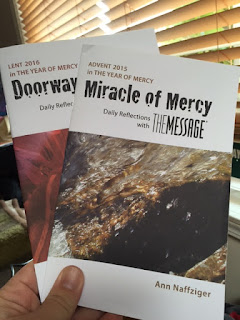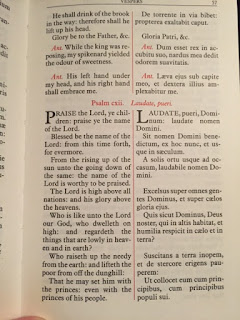So, this past summer, I was able to review their hardback classic edition of True Devotion to the Blessed Virgin Mary. I decided to purchase it, since I had never owned any of their "hardback classic" books as well as the fact that I had lost a nice edition of True Devotion during the flood of August 2014. It remains a beautiful edition, which I refer to often. At the time, I concluded my review by encouraging you consider these hardback classics, since: "They sell-out quickly, so if there is something you like, I'd advise that you get it. Some of them will be printed again, but which ones and how many is uncertain." Fortunately, Baronius has reprinted some of their best editions in the hardback classic series, including the works of St. Teresa of Avila, St. John of the Cross, St. Catherine of Sienna, as well as a few others. Baronius gladly sent me two review copies to consider, The Rule of Saint Benedict and The Way of Perfection by St. Teresa of Avila.
 I will not spend any time discussing the content of these venerable works, since they are truly classics in the Catholic tradition. My focus is on the quality of the actual book, which, once again, is very impressive. Sometimes I wonder if my enthusiasm towards the books done by Baronius Press is due to the lack of quality in most other books coming from a majority of Catholic publishers or is it just that Baronius does a splendid job. I think it is a little bit of both.
I will not spend any time discussing the content of these venerable works, since they are truly classics in the Catholic tradition. My focus is on the quality of the actual book, which, once again, is very impressive. Sometimes I wonder if my enthusiasm towards the books done by Baronius Press is due to the lack of quality in most other books coming from a majority of Catholic publishers or is it just that Baronius does a splendid job. I think it is a little bit of both. To start with, the covers are bound in bonded leather. As the Baronius website points out, "the hardcover editions use the same (bonded) leather covered over 1/8" (1/12" for smaller titles) thick, stiff boards, to create strong and durable books that will last for generations." In addition, all their hardback books, and Bibles, are sewn, which is always a must for me when I am deciding on purchasing any book that I plan to use often or give as a gift. The quality of the cover and binding allows for a wonderful reading experience. It just feels great to hold and the sewn binding allows you to open it flat without any issues. When I am holding a Baronius book I have this feeling that this is how books were produced fifty or a hundred years ago. I have a number of first edition books by Msgr. Knox, with a few of them being close to 80 years old. They are sewn and are still in great condition. (They even have that nice old smell to them.) I can imagine that these Baronius editions will have the same look and feel a hundred years into the future. (Perhaps even that same smell too!)

When you finally open up the book, you will find a page layout that is clear, easy on the eyes, and inviting to be read. The paper is thick, not thin like their bibles. The print is dark and well spaced. They are not facsimiles of older editions, but rather each volume as been newly re-typset, which makes a world of difference. What all this means is that every page your read from is aesthetically beautiful and contains virtually no issues relating to ghosting or bleed through. Although I wouldn't dream of doing it, one could probably safely write notes in these books with no worry of it being seen through on the next page. I typically have time to read either early in morning or late at night, after my kids have gone to bed. Never has there been a time when I couldn't read either of these books at any point in the day. They read great at the beginning of the day, even now when the sun isn't up yet, or at the end of the day when I am sitting in my comfy chair next to a dimly lit lamp.
 The typical Baronius extras are also present in these volumes. Each comes with a soft satin ribbon which is always better than using a paper bookmark. When you are reading a volume as nicely crafted as these, it would be noticeable if there weren't a ribbon marker present. Along with the ribbon you will also find head and tail bands. (Headbands originated in Victorian England as a way of covering the unsightly spine sewing at the head and tail of the book block.) Last, but not least, are one of my favorite features of the many books I own from Baronius: Endpapers! Yeah, maybe you are wondering why I like them so much? I can't really say, to be honest. All I know is that when you regularly use books that do have them, you begin to notice which of your nicer books that don't have them. Again, some of my more vintage books contain them, and I just feel like they add a bit of class to the volume. Baronius explains: "The endpapers are made of thick heavy-weight paper, decoratively printed with traditional Catholic symbols, marble motives or other designs in wide array of colours according to the colour of the cover, complementing the overall design of the book." When I had my Knox Bible rebound back in 2013, the one thing I realized after the fact was that those lovely Knox endpapers were going to be lost. I still miss those endpapers! I have even toyed with the idea of re-ordering another Knox hardcover from Baronius. (That might be a bit too much, and I am not sure my wife would go for it.)
The typical Baronius extras are also present in these volumes. Each comes with a soft satin ribbon which is always better than using a paper bookmark. When you are reading a volume as nicely crafted as these, it would be noticeable if there weren't a ribbon marker present. Along with the ribbon you will also find head and tail bands. (Headbands originated in Victorian England as a way of covering the unsightly spine sewing at the head and tail of the book block.) Last, but not least, are one of my favorite features of the many books I own from Baronius: Endpapers! Yeah, maybe you are wondering why I like them so much? I can't really say, to be honest. All I know is that when you regularly use books that do have them, you begin to notice which of your nicer books that don't have them. Again, some of my more vintage books contain them, and I just feel like they add a bit of class to the volume. Baronius explains: "The endpapers are made of thick heavy-weight paper, decoratively printed with traditional Catholic symbols, marble motives or other designs in wide array of colours according to the colour of the cover, complementing the overall design of the book." When I had my Knox Bible rebound back in 2013, the one thing I realized after the fact was that those lovely Knox endpapers were going to be lost. I still miss those endpapers! I have even toyed with the idea of re-ordering another Knox hardcover from Baronius. (That might be a bit too much, and I am not sure my wife would go for it.) Let me just say, in conclusion, that the hardback classic series from Baronius Press are well worth your time and money. They are all reasonably priced, with none of the ones currently available listing for more than $30. Actually, I think they are more than affordable considering the time, effort, and quality that goes into each edition. (I recently purchased a paperback book for more than $30!) These are beautifully crafted editions from our Catholic tradition, which will indeed last a lifetime. They also make great gifts for the coming Christmas season. As I mentioned last time, I wouldn't recommend waiting too long to purchase anything Baronius Press produces. They do not mass produce their books, bibles, or missals, rather they lovingly craft volumes in limited quality in a format that is fitting the author whose words are contained within.
Again, I would like to thank Baronius Press for providing these two review copies for this post.






















